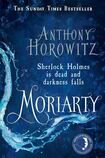
Anthony Horowitz's Moriarty presents, to paraphrase Arthur Conan Doyle, something of a two-pipe problem. The story opens in 1891, in the wake of the events at the Reichenbach Falls, where Sherlock Holmes and his nemesis Professor Moriarty both perished. "Sherlock Holmes is dead" runs the cover's doom-laden strapline, "and darkness falls".
Yes and no. Even the most casual mystery aficionado will know that Holmes did not die in The Final Problem, despite the fervent wishes of his creator. Popular demand meant that Holmes turned up alive and well in London in 1894, after a three-year gap that Conan Doyle's fans describe as the great hiatus.
Horowitz, the only writer authorized to write Sherlock Holmes stories by Conan Doyle's estate, is alive to the humorous potential of the detective's death-defying feats. "Does anyone really believe what happened at the Reichenbach Falls?" asks our narrator, Pinkerton agent Frederick Chase, in the novel's opening line. Horowitz, responsible for his share of improbable murder mysteries on television – Midsomer Murders, Foyle's War, Poirot – then goes on to pick an Albert's Hall worth of holes out of Conan Doyle's plot in The Final Problem.
Moriarty offers a tangential, slyly knowing take on the fictional world created by Arthur Conan Doyle. In Switzerland in pursuit of Holmes, Chase encounters the Scotland Yard inspector Athelney Jones, a minor player in the Holmes canon. Moriarty might be dead, Chase tells Jones, but a more sinister game is afoot. For some time Moriarty has been in cahoots with Clarence Devereux, "the master of the American underworld".
With Moriarty dead, the way is clear for the utterly ruthless Devereux to expand his criminal empire into London and beyond. When the pair discover a coded message to Professor Moriarty on the drowned man’s body, sent by Devereux and arranging a meeting with Moriarty in London, they agree to pool their resources.
Their relationship, too, is quickly established. Jones, the Scotland Yard man with official authority, confesses to being a disciple of Holmes and employs his methods of detection. He will be the lead investigator. Chase, who has no official role in London, will observe events and, Watsonlike, play the part of his biographer.
Imitation as flattery
It’s an interesting gambit. Even if a contemporary writer re-creates Holmes to an uncanny degree, it can only ever be an ersatz version of Conan Doyle’s stories. But a range of possibilities opens up when Horowitz dips into the world Conan Doyle created and extracts similar characters with a similar way of investigating mysteries.
Given that this year has seen new novels featuring re-creations of Philip Marlowe (by Benjamin Black) and Hercule Poirot (by Sophie Hannah), the process of doing so raises interesting questions about why readers of crime fiction have gotten so nostalgic for the heroes of a bygone age.
That said, Horowitz takes the concept only so far. Despite the title, it’s the shadow of Sherlock Holmes that permeates virtually every page of the novel. Insp Jones isn’t so much a new take on the Holmes model of detection as a man engaged in a perverse kind of ventriloquism. He mutters “Elementary” on occasion, declares that a particular mystery is “a three-pipe problem” and modestly concedes that “Where Holmes has gone, I have merely followed”.
Jones suggests to Chase that they set up as a private-detective partnership – and that their offices should be situated around the corner from Baker Street. A bitter Mrs Jones says, “He has made Sherlock Holmes the very paradigm of his own life.”
Authentic writing
Horowitz writes beautifully about late-Victorian London, and some of the scenes verge on Dickensian in their evocation of its poverty and decay, the casual brutality of daily life and the riotous bustle of the docks.
Meanwhile, the story fairly gallops along, enlivened by shootings, explosions, kidnaps and murders. The twists and reversals of fortune are given an added frisson by the dramatic revelation at the denouement.
“It is like reading a book in which the chapters have been published in the wrong order,” Jones complains as he tries to piece together the jigsaw of his investigation of the elusive Devereux. “Or where the writer has deliberately set out to confuse.” Unwary readers would do well to take note of Jones’s words.
Ultimately, Moriarty has its cake by playfully re-creating the Sherlock Holmes persona and eats it by poking gentle fun at his methodology – and, by extension, his enduring appeal. "Much of what [Holmes] said was unsound, unscientific and occasionally preposterous," a Scotland Yard official harrumphs. "We believed him because he got results, but it was not a sound platform for modern detective work."
Anthony Horowitz may not be the most reverential of the many writers who have attempted to breathe new life into the legacy of Sherlock Holmes, but Moriarty proves that he is certainly one of the most entertaining.
Declan Burke's latest novel is Crime Always Pays (Severn House)












